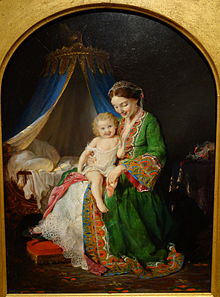This Little Piggy
| "This Little Piggy" | |
|---|---|
 Illustration by Lilly Martin Spencer, 1857 | |
| Nursery rhyme | |
| Published | 1760 |
| Songwriter(s) | Unknown |
"This Little Pig Went to Market" (often shortened to "This Little Piggy") is an English-language nursery rhyme and fingerplay. It has a Roud Folk Song Index number of 19297.
Lyrics
[edit]
The rhyme is usually counted out on an infant or toddler's toes, each line corresponding to a different toe,[2] usually starting with the big toe and ending with the little toe.[3]
One popular version is:
| Words | Fingerplay |
|---|---|
|
Wiggle the "big" toe |
Origins
[edit]In 1728, the first line of the rhyme appeared in a medley called "The Nurses Song". The first known full version was recorded in The Famous Tommy Thumb's Little Story-Book, published in London about 1760. In this book, the rhyme goes:[4]
This pig went to market,
That pig stayed home;
This pig had roast meat,
That pig had none;
This pig went to the barn's door,
And cried week, week for more.[5]
The full rhyme continued to appear, with slight variations, in many late 18th- and early 19th-century collections. Until the mid-20th century, the lines referred to "little pigs".[4] It was the eighth most popular nursery rhyme in a 2009 survey in the United Kingdom.[6]
References
[edit]- ^ Wentworth, George; Smith, David Eugene (1912). Work and Play with Numbers. Boston: Ginn & Company. p. 14.
- ^ Bronner, Simon J. (2019). The Oxford Handbook of American Folklore and Folklife Studies. Oxford University Press. p. 175. ISBN 9780190840617.
- ^ a b Herman, D. (2007). The Cambridge Companion to Narrative. Cambridge: Cambridge University Press. p. 9.
- ^ a b Opie, I.; Opie, P. (1951). The Oxford Dictionary of Nursery Rhymes (1997 ed.). Oxford University Press. pp. 349–50.
- ^ The Famous Tommy Thumb's Little Story-Book. 1760. p. 30.
- ^ Falush, Simon (7 October 2009). "Nursery rhymes "too old fashioned" for modern kids". Reuters Life!.
